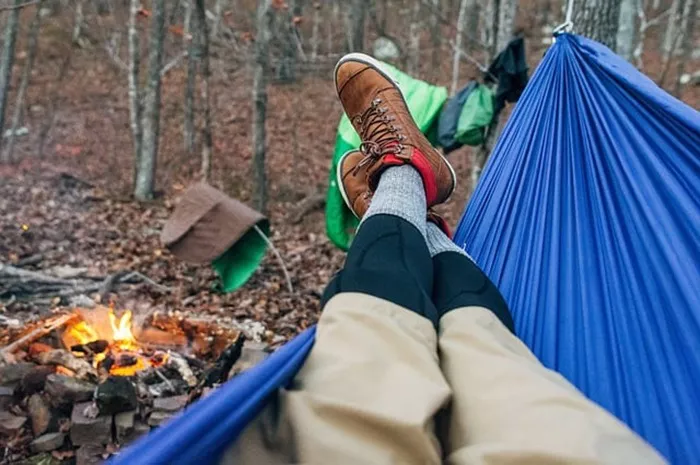Hammock camping has become popular in recent years. Many campers enjoy the comfort and convenience of sleeping off the ground. But is hammock camping safe? The answer is yes, if you follow proper guidelines. This article will explore safety concerns and how to avoid risks.
Benefits of Hammock Camping
Hammock camping offers several advantages over traditional tent camping.
- Comfort: Hammocks provide better support for your back. They reduce pressure points compared to sleeping on the ground.
- Versatility: You can set up a hammock almost anywhere with two sturdy anchor points.
- Protection from ground hazards: No need to worry about rocks, roots, or wet ground.
- Better airflow: Hammocks keep you cooler in hot weather.
- Lightweight and portable: Hammocks are easy to carry, making them great for backpacking.
Despite these benefits, safety depends on proper setup and use.
Potential Risks of Hammock Camping
While hammock camping is generally safe, there are some risks to consider.
1. Falling from the Hammock
Falling is the most common concern. This can happen if:
- The hammock is not properly secured.
- The straps or ropes break.
- The hammock is overloaded beyond its weight limit.
- The user moves too much while sleeping.
2. Anchor Point Failure
If the trees or posts holding the hammock are weak or rotten, they can break. This can cause injury.
3. Exposure to Cold Air (Cold Butt Syndrome)
Hammocks allow air to circulate underneath. Without insulation, campers can lose body heat quickly, leading to discomfort or even hypothermia.
4. Insect and Wildlife Encounters
Sleeping above ground doesn’t always protect you from bugs or animals. Mosquitoes, spiders, and even small mammals can still be a problem.
5. Improper Setup Leading to Injury
A poorly hung hammock can cause back pain or muscle strain. If set up too high, falling becomes more dangerous.
How to Make Hammock Camping Safer
Follow these tips to minimize risks and ensure a safe hammock camping experience.
1. Choose a High-Quality Hammock
Not all hammocks are the same. Look for:
- Strong materials: Ripstop nylon or polyester are durable.
- Weight capacity: Check the manufacturer’s limit and stay well below it.
- Reinforced stitching: Prevents tearing under pressure.
- Reliable suspension system: Sturdy straps or ropes with strong carabiners.
2. Select Safe Anchor Points
- Use healthy, sturdy trees (at least 6 inches in diameter).
- Avoid dead or rotting trees.
- If trees are not available, use hammock stands designed for camping.
- Never attach a hammock to weak structures like fence posts or small branches.
3. Hang the Hammock Correctly
- The ideal hanging angle is 30 degrees from horizontal.
- The hammock should sag slightly when you lie in it.
- Keep the height low to the ground (about 18 inches) to reduce fall risk.
- Test the setup before fully committing your weight.
4. Use Proper Insulation
- A sleeping pad inside the hammock helps retain body heat.
- An underquilt (insulation hung beneath the hammock) provides warmth in cold weather.
- A top quilt or sleeping bag keeps you cozy.
5. Protect Against Insects and Animals
- Use a bug net to keep mosquitoes and other pests away.
- Avoid leaving food in or near the hammock to prevent attracting wildlife.
- Check for spiders or ants before setting up.
6. Practice Safe Entry and Exit
- Sit first, then swing your legs in slowly.
- Avoid jumping or making sudden movements.
- Exit carefully to prevent tipping over.
7. Check Weather Conditions
- Avoid hammock camping in strong winds or storms.
- Heavy rain can make straps slippery or weaken anchor points.
- Lightning is dangerous when suspended above the ground.
Hammock Camping Safety Gear
The right equipment makes hammock camping much safer. Essential gear includes:
1. Hammock Straps (Not Ropes)
- Wide, tree-friendly straps distribute weight and prevent bark damage.
- Avoid thin ropes that can cut into trees or snap under tension.
2. Carabiners and Hardware
- Use load-rated carabiners (at least 500 lbs capacity).
- Check for wear and rust before each trip.
3. Rain Tarp
- A waterproof tarp keeps you dry in wet weather.
- Set it up at an angle to allow rain runoff.
4. Bug Net
- A full-coverage net keeps insects out.
- Ensure it’s properly sealed with no gaps.
5. Insulation (Underquilt and Top Quilt)
- Essential for cold-weather camping.
- Prevents heat loss through the bottom of the hammock.
Common Myths About Hammock Camping Safety
Myth 1: “Hammocks Are Unstable and Easy to Flip Over”
Fact: A properly hung hammock is very stable. Most flipping happens due to incorrect setup or excessive movement.
Myth 2: “Hammocks Are Only for Warm Weather”
Fact: With proper insulation (underquilt and top quilt), hammocks can be used in freezing temperatures.
Myth 3: “You Need Perfect Trees to Hang a Hammock”
Fact: Hammock stands and alternative anchoring methods allow setup even without trees.
Myth 4: “Hammocks Are Bad for Your Back”
Fact: When hung correctly, hammocks provide excellent lumbar support and reduce pressure points.
Final Safety Tips for Hammock Camping
- Always inspect gear before use.
- Practice setting up at home before going camping.
- Start low: Hang the hammock close to the ground.
- Check weight limits: Don’t exceed the hammock’s capacity.
- Bring backup gear: Extra straps or a lightweight tent as a backup.
Conclusion
Hammock camping is safe if done correctly. The key risks—falling, anchor failure, cold exposure, and wildlife—can all be managed with proper setup and gear. By choosing quality equipment, hanging the hammock correctly, and using insulation, campers can enjoy a comfortable and secure night’s sleep. Whether you’re a beginner or an experienced camper, following these safety guidelines will help you make the most of hammock camping.
Would you like to try hammock camping? Start with a short trip in good weather to get comfortable with the setup. Happy camping!
Related topics:
What Can You Do When You Go Camping?

